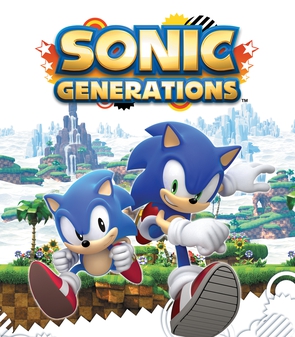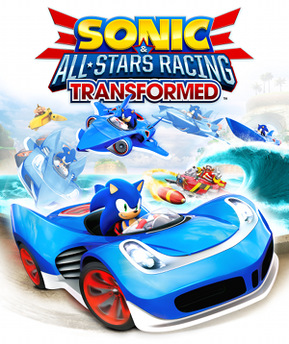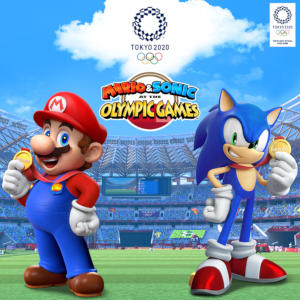
Sonic the Hedgehog is a 1991 platform game developed by Sonic Team and published by Sega for the Genesis/Mega Drive. It was released in North America on June 23 and in PAL regions and Japan the following month. Players control Sonic the Hedgehog, who can run at near supersonic speeds; Sonic sets out on a quest to defeat Dr. Robotnik, a scientist who has imprisoned animals in robots and seeks the powerful Chaos Emeralds. The gameplay involves collecting rings as a form of health, and a simple control scheme, with jumping and attacking controlled by a single button.

Yuji Naka, credited in some games as YU2, is a former Japanese video game programmer, designer and producer. He is the co-creator of the Sonic the Hedgehog series and was the president of Sonic Team at Sega until his departure in 2006.

Sonic Advance, known as SonicN on the N-Gage, is a 2001 platform game developed by Dimps and published by Sega for the Game Boy Advance. It was the first Sonic the Hedgehog game released on a Nintendo console with Sonic Adventure 2: Battle on the GameCube, and was produced in commemoration of the series' tenth anniversary. The story follows Sonic, Tails, Knuckles, and Amy as they journey to stop Doctor Eggman from taking over the world. Controlling a character, players are tasked with completing each level, defeating Eggman and his robot army, and collecting the seven Chaos Emeralds.

Green Hill Zone is the first level of the platform game Sonic the Hedgehog, which released for the Sega Genesis in 1991. The level is grassy and lush, with environmental features such as palm trees, vertical loops and cliffs, and is the home of numerous forest animals. Like the game's other levels, Green Hill comprises 3 acts; in the third, Sonic fights antagonist Doctor Eggman before moving to the second level, Marble Zone. It was constructed by level designer Hirokazu Yasuhara with its musical theme by Masato Nakamura.

Sonic the Hedgehog 2 is a 1992 platform game developed by Aspect and published by Sega for the Master System and Game Gear. It is the sequel to the 8-bit Sonic the Hedgehog (1991) and follows Sonic as he attempts to get the Chaos Emeralds back to rescue his friend Miles "Tails" Prower from Dr. Robotnik. Like the first Sonic the Hedgehog, players run through levels at high speeds while collecting rings and defeating enemies. Although it shares the same title with Sonic the Hedgehog 2 for the Sega Genesis and their releases coincided, the games have little in common and share no levels.

Sonic the Hedgehog is a video game series and media franchise created by the Japanese developers Yuji Naka, Naoto Ohshima, and Hirokazu Yasuhara for Sega. The franchise follows Sonic, an anthropomorphic blue hedgehog who battles the evil Doctor Eggman, a mad scientist. The main Sonic the Hedgehog games are platformers mostly developed by Sonic Team; other games, developed by various studios, include spin-offs in the racing, fighting, party and sports genres. The franchise also incorporates printed media, animations, feature films, and merchandise.

Mario & Sonic at the Olympic Games is a 2007 crossover sports and party game developed by the Sega Sports R&D Department. It is the first installment on the Mario & Sonic series. It was published by Nintendo in Japan and by Sega in other regions, and released on the Wii in November 2007 and the Nintendo DS handheld in January 2008. The first official video game of the 2008 Summer Olympic Games, it is licensed by the International Olympic Committee (IOC) through exclusive licensee International Sports Multimedia (ISM), and is the first official crossover game to feature characters from both the Mario and Sonic the Hedgehog series.

Mario & Sonic at the Olympic Winter Games is a 2009 sports and party game developed by Sega. Like its predecessor, it was published by Nintendo for Japan and Korea and by Sega in the Western world. The game is officially licensed by the International Olympic Committee (IOC) through exclusive license International Sports Multimedia. The game is the third official crossover title to feature characters from both Mario and Sonic's respective universes, the first and second being the game's predecessor Mario & Sonic at the Olympic Games and Super Smash Bros. Brawl respectively. It was released on the Wii and the Nintendo DS in October 2009, and is the first official video game of the 2010 Winter Olympic Games.

Sonic & Sega All-Stars Racing is a 2010 kart racing video game developed by Sumo Digital and published by Sega. It was released for Wii, Xbox 360, PlayStation 3, Nintendo DS, and Windows, featuring characters from multiple Sega franchises. The game is the third title in the Sega All-Stars series, preceded by Sega Superstars Tennis. A mobile version was developed by Gameloft, and released for iOS in June 2011, as a paid download. A version for OS X was released by Feral Interactive in April 2013.

Sonic Colors is a 2010 platform game published by Sega. It follows Sonic's quest to stop his nemesis Doctor Eggman from enslaving an alien race and taking over the world. The gameplay is similar to prior Sonic games, with players collecting rings and defeating enemies; the camera perspective often switches from third-person to side-scrolling perspectives. The game also introduces Wisps, power-ups the player can use to increase attack power and reach new areas.

Sonic Generations is a 2011 platform game developed by Sonic Team and published by Sega for the PlayStation 3, Xbox 360, Windows, and Nintendo 3DS. Produced in commemoration of the 20th anniversary of the Sonic the Hedgehog series, the game follows Sonic and his sidekick Tails as they form an alliance with their modern selves. It features two gameplay styles: "Classic", which plays from a side-scrolling perspective like that of the original Sega Genesis Sonic games, and "Modern", 3D levels similar to those in Sonic Unleashed (2008) and Sonic Colors (2010).

Sonic & All-Stars Racing Transformed is a kart racing video game developed by Sumo Digital and published by Sega. It was released for the PlayStation 3, Xbox 360, and Wii U in November 2012; for PlayStation Vita in December 2012; for Windows in January 2013; for Nintendo 3DS in February 2013; and for Android and iOS devices in January 2014. The PS3 and Wii U versions of the game were released in Japan on May 15, 2014.

Sonic Lost World is a 2013 platform game developed by Sonic Team. It is part of the Sonic the Hedgehog series, and was released in October 2013 for the Wii U and Nintendo 3DS in PAL regions by Nintendo and by Sega in North America and Japan. A port of the Wii U version for Windows was later released in November 2015.

Mario & Sonic at the Sochi 2014 Olympic Winter Games is a 2013 crossover sports/party video game for the Wii U. It is the fourth game in the Mario & Sonic series, the first to be released on the Wii U and is the official video game for the 2014 Winter Olympics that were held in Sochi. It was released on November 8, 2013, in Europe, November 9, 2013, in Australia, November 15, 2013, in North America, and December 5, 2013, in Japan.

Sonic Boom: Shattered Crystal is a 2014 action-adventure game developed by Sanzaru Games and published by Sega for the Nintendo 3DS. Along with its Wii U sibling Sonic Boom: Rise of Lyric, Shattered Crystal is a spin-off of Sega's Sonic the Hedgehog franchise and is a part of the Sonic Boom sub-franchise, which consists also of an animated television series, whose games serve as its prequels. The two games together formed the third and final part in Sega's exclusivity agreement with Nintendo, following Sonic Lost World and Mario & Sonic at the Sochi 2014 Olympic Winter Games in 2013.

Sonic Boom: Rise of Lyric is a 2014 action-adventure platform video game developed by Big Red Button and published by Sega for the Wii U. Along with Sonic Boom: Shattered Crystal for the Nintendo 3DS, it is a spin-off of Sega's Sonic the Hedgehog series and is a part of the Sonic Boom franchise, which also consists of an animated television series, a comic series by Archie Comics, and a toyline by Tomy. The storyline follows Sonic, Tails, Knuckles and Amy, who must stop Lyric the Last Ancient from acquiring the Chaos Crystals by powering up a robot army and wiping out all organic life, after Sonic accidentally awakens Lyric from a thousand year rest, while escaping Doctor Eggman.

Mario & Sonic at the Rio 2016 Olympic Games is a 2016 crossover sports and party game in the Mario & Sonic at the Olympic Games series, released for the Nintendo 3DS in February 2016 in Japan, March 2016 in North America, and in April 2016 for Europe and Australia, and for the Wii U worldwide in June 2016. The game is officially licensed by the International Olympic Committee, as are the other games in the series. It was developed by Sega, with assistance from Arzest and Spike Chunsoft, and published by Nintendo. It is the fifth title in the Mario & Sonic at the Olympic Games series. The game is a collection of Olympic sports themed mini-games featuring characters from the Mario series and the Sonic the Hedgehog series.

Mario & Sonic at the Olympic Games Tokyo 2020 is a 2019 sports video game based on the 2020 Summer Olympics. It is the sixth game in the Mario & Sonic series, a crossover between Nintendo's Super Mario and Sega's Sonic the Hedgehog franchises, and the first since the Rio 2016 Olympic Games edition. It was developed and published by Sega for the Nintendo Switch in November 2019 and for arcade cabinets in 2020.




















